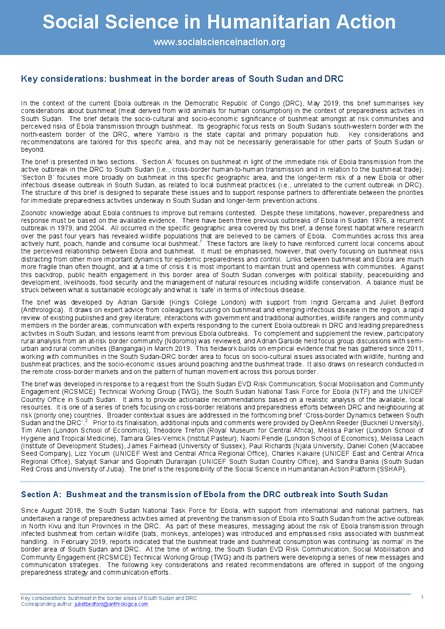
In the context of the current Ebola outbreak in the Democratic Republic of Congo (DRC), May 2019, this brief summarises key considerations about bushmeat (meat derived from wild animals for human consumption) in the context of preparedness activities in South Sudan. The brief details the socio-cultural and socio-economic significance of bushmeat amongst at risk communities and perceived risks of Ebola transmission through bushmeat. Its geographic focus rests on South Sudan’s south-western border with the north-eastern border of the DRC, where Yambio is the state capital and primary population hub. Key considerations and recommendations are tailored for this specific area, and may not be necessarily generalisable for other parts of South Sudan or beyond.
The brief is presented in two sections. ‘Section A’ focuses on bushmeat in light of the immediate risk of Ebola transmission from the active outbreak in the DRC to South Sudan (i.e., cross-border human-to-human transmission and in relation to the bushmeat trade). ‘Section B’ focuses more broadly on bushmeat in this specific geographic area, and the longer-term risk of a new Ebola or other infectious disease outbreak in South Sudan, as related to local bushmeat practices (i.e., unrelated to the current outbreak in DRC). The structure of this brief is designed to separate these issues and to support response partners to differentiate between the priorities for immediate preparedness activities underway in South Sudan and longer-term prevention actions.
Zoonotic knowledge about Ebola continues to improve but remains contested. Despite these limitations, however, preparedness and response must be based on the available evidence. There have been three previous outbreaks of Ebola in Sudan: 1976, a recurrent outbreak in 1979, and 2004. All occurred in the specific geographic area covered by this brief, a dense forest habitat where research over the past four years has revealed wildlife populations that are believed to be carriers of Ebola. Communities across this area actively hunt, poach, handle and consume local bushmeat. These factors are likely to have reinforced current local concerns about the perceived relationship between Ebola and bushmeat. It must be emphasised, however, that overly focusing on bushmeat risks distracting from other more important dynamics for epidemic preparedness and control. Links between bushmeat and Ebola are much more fragile than often thought, and at a time of crisis it is most important to maintain trust and openness with communities. Against this backdrop, public health engagement in this border area of South Sudan converges with political stability, peacebuilding and development, livelihoods, food security and the management of natural resources including wildlife conservation. A balance must be struck between what is sustainable ecologically and what is ‘safe’ in terms of infectious disease.
